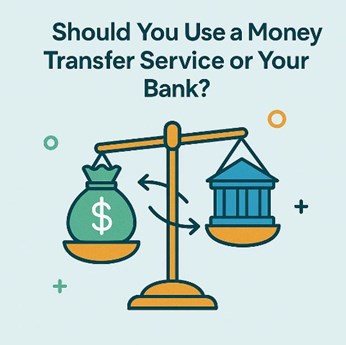Should You Use a Money Transfer Service or Your Bank?

Should You Use a Money Transfer Service or Your Bank?
Introduction
Sending money is now a daily task—splitting rent, paying contractors, helping family abroad, or moving funds between accounts. The tricky part is deciding whether a money transfer service or your bank is the smarter route. Costs, exchange rates, speed, limits, and convenience vary widely. This guide breaks down the trade-offs so you can choose the best method for each situation and avoid hidden costs.
1) Start with the true total cost
Comparing providers by headline “no fee” offers can mislead you. The real number is total landed cost:
- Up-front fees (flat or percentage).
- FX markup (the spread between the mid-market exchange rate and the rate you’re offered).
- Receiving/intermediary fees on the other side.
- Any withdrawal or cash-out costs for the recipient.
- When you add these together, a service with a small fee but a steep FX spread may cost more than a bank wire—or vice versa.
2) Speed and certainty matter
Consider how quickly the recipient needs funds and how certain you need the arrival time to be.
- Domestic bank transfers and ACH can take 1–2 business days; wires are faster but usually carry fees.
- Many international money transfer apps deliver within minutes or hours, especially to popular corridors.
- For large sums, banks may offer predictable timelines and stronger paper trails, which some recipients (and auditors) prefer.
3) Limits, documentation, and compliance
- Larger transfers often face stricter verification. Expect ID checks, source-of-funds questions, and proof of purpose.
- Banks typically allow higher wire transfer limits and can accommodate large transactions with advance notice.
- Money transfer services may raise limits as your account ages or after extra verification.
- For cross-border business payments, factor in compliance comfort—banks may reduce questions later if a relationship manager understands your pattern.
4) Convenience and user experience
A great interface saves time and reduces mistakes:
- Apps that store recipients, show guaranteed rates for a time window, and provide tracking reduce anxiety.
- Web portals with real-time exchange rate quotes let you compare providers before committing.
- Consider support channels: live chat, weekend service, multilingual help for recipients.
5) When a money transfer service usually wins
- Small-to-medium international transfers where FX markup drives the bulk of cost.
- Urgent payments to wallets or cash pickup networks in areas with limited banking.
- Frequent senders who benefit from loyalty pricing or lower percentage fees.
- Senders who value transparent mid-market rates and instant quotes.
- Useful keywords naturally included: “best way to send money,” “low-fee international money transfer,” “fast money transfer,” “transparent exchange rates.”
6) When a bank is the better choice
- Large transfers where absolute security and a long-form paper trail are paramount.
- Payments to business vendors who prefer SWIFT wires into corporate accounts.
- Transactions that must sit neatly inside your existing online banking and accounting workflow.
- Situations where you can access relationship pricing or bundled services that cut fees.
7) Avoid common pitfalls
- Don’t ignore “guaranteed rate” windows; rates can move quickly.
- Always confirm the recipient’s details (IBAN/SWIFT, routing, account name) to prevent returns and extra fees.
- Test with a small transfer to a new recipient.
- Watch out for weekend transfers that settle on the next business day—set expectations with recipients.
- Keep screenshots and receipts; they help resolve disputes fast.
8) A quick decision framework you can reuse
Ask yourself:
- Is speed or cost more important for this transfer?
- Is this domestic or cross-border, and how price-sensitive is the recipient to fees on their end?
- What amount am I sending, and do I need a bank-level paper trail?
- Which option gives me the lowest total landed cost today with acceptable delivery certainty?
- This mental checklist gets you to a smart choice in under a minute.
Conclusion
There’s no single “best” method for every situation. For smaller or frequent cross-border payments, a money transfer service often wins on transparency, speed, and FX value. For large amounts, sensitive vendor payments, or when you need the strongest audit trail, a bank wire transfer can be the safer, cleaner route. If you’d like personalized guidance on cost, speed, and compliance for your specific corridor, PAY Financial Service in Sayreville, NJ, can help you compare options and set a simple, repeatable process.
Searching for Financial & Taxation Services? Let’s make your search simple with professionals!
Take your Financial & Taxation Services to the next level with Sulekha. Boost your online visibility, connect with more clients, and grow effortlessly!
Blogs Related to Financial & Taxation Services

How Do You Find the Right Life Insurance Policy?
How Do You Find the Right Life Insurance Policy? Life insurance is more than a safety net—it’s a cornerstone of sound financial planning. Whether you’re protecting your family’s future, securing your business, or planning your estate, finding the ri

Why Is Investment Management Critical for High-Net-Worth Individuals?
Why Is Investment Management Critical for High-Net-Worth Individuals? Wealth accumulation is an achievement—but managing it effectively is an even greater challenge. For high-net-worth individuals (HNWIs), wealth management requires precision, fores

Are You Paying Too Much in Taxes? What You Need to Know About Deductions
Are You Paying Too Much in Taxes? What You Need to Know About Deductions Every year, millions of Americans overpay their taxes—often without realising it. The reason? Missed deductions, overlooked credits, and a lack of strategic tax planning. Wheth

Ready to Start a Business, But Is an Incorporation Service Right for You?
Ready to Start a Business, But Is an Incorporation Service Right for You? Starting a business is an exciting milestone—but it’s also a decision that carries long-term financial and legal consequences. One of the most important early steps is decidin

Do You Make These Mistakes When Applying for Financial Aid?
Do You Make These Mistakes When Applying for Financial Aid? Financial aid can make the difference between attending your dream college and settling for an alternative. Yet, every year, millions of students and parents lose out on potential grants, s

How Do You Choose the Right Financial Advisor for Your Needs?
How Do You Choose the Right Financial Advisor for Your Needs? Choosing a financial advisor isn’t just about finding someone who understands money—it’s about finding a trusted partner who understands your financial goals, challenges, and long-term vi




